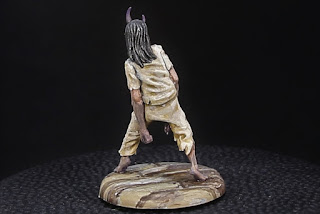Overall, I love playing the Malifaux Freikorps on the table, but the minis tend to give way to an obvious militant drab green palette a la camouflage. It's... fine... but for near turn of the 20th century, it's still a little early to be jumping into the WWI style. And the navy blues of the Prussian military around that time seem very flat to me. The suits should be made of leather but I wanted to do something different than the reddish-brown Cinnamon style that I overused in my early painting days.
That leaves me with something brown, and straight brown is very bland. So I wanted to breathe a little life in to an ochre palette:
- Reaper Military Grey
- Reaper Dark Skin / FolkArt Cafe Latte
- FolkArt English Mustard / Yellow Ochre
- Apple Barrel Antique White
I added a few others into the palette
- FolkArt Butter Pecan
- FolkArt Linen for Highlights
The main color triad focused on Reaper HD Military Grey, FolkArt Butter Pecan, and FolkArt English Mustard / Yellow Ochre.
So I knew where to start. But where to go afterwards was a matter of "let's see when we get there."
So I knew where to start. But where to go afterwards was a matter of "let's see when we get there."
To start I used grey primer, black wash and white drybrush.
First coats of Reaper HD Military Blue on the clothing, Butter Pecan on the leather padding, Yellow Ochre on the boots and book binding.
First washes.
First run on highlights
Mixed Military Grey with FolkArt French Blue in dark to light tones for highlights. Vallejo Cold Grey on the metal parts with some Citadel Nuln Oil for separation. To "leather up" the shoulder pads and breast areas (originally in FolkArt Butter Pecan), I put my first trial of Citadel Contrast Paints - Skeleton Horde. But not all over just nearest the creases.
Parchment on the book pages. Heavy glaze of Reaper Military Grey on front side of legs to blend highlights a little. Nuln Oil on the dagger and for some separation. Highlights with Parchment on the whiter leather bits (not as visible in picture as angle of photo is slightly bottom up).
At this point, while I was happy with the general color scheme, I had the ribbons and the goggles to go. The ribbon I decided to run counterpoint with the set scheme and use an accent color of Red to make the figure pop a little. Reaper HD Brilliant Red, Delta Cinnamon, and highlights mix of Billiant Red and Antique White.
The goggles took more fretting because I had to decide whether to show the eyes (which would have been very difficult given the size) or try a reflection like it was glass. I chose the glass option.
Cobalt Blue wash
Vallejo Turquoise
Dot of a mix of Vallejo Turquoise and French Blue
Touch up goggles English Mustard and Antique White
This ended up being my color scheme.
This ended up being my color scheme.
- Clothes - Main Base: Heavy Glaze of Reaper HD Military Grey, Shadow (Wash): FolkArt Cobalt Blue, Highlights: Mix of Military Grey with FolkArt French Blue
- Padded Leather - Main Base: Heavy Glaze of FolkArt Butter Pecan, Shadow (Selective Wash): Citadel Contrast Paint Skeleton Horde, Highlight 1: FolkArt Linen; Highlight 2: FolkArt Linen and FolkArt Parchment
- Shoe - Base: FolkArt Cafe Latte, Shadow (Wash): Reaper Dark Skin, Highlights: Reaper Dark Skin Highlight
- Shin Strap, Book Cover, Dagger Handle Wraps - Base: FolkArt English Mustard , Shadow (Wash): English Mustard and Reaper Dark Skin, Highlights: FolkA rt Yellow Ochre, and selective mix of Yellow Ochre and Apple Barrel Antique White
- Book Pages - Base: Apple Barrel Antique White, Shadow (Wash): Nuln Oil (though it should have been Agrax Earthshade), Highlights: FolkArt Parchment
- Metal Bits - Base: Vallejo Cold Metal, Shadow (Wash): Citadel Nuln Oil, Highlights: mix of Vallejo Cold Metal and Reaper Cloudy Grey and Misty Grey
- Ribbon - Base: Reaper HD Brilliant Red, Shadow (Wash): Delta Cinnamon, Highlights: mix of Brilliant Red and Antique White
- Goggles Outside (similar to Padded Leather minus Contrast Paints) - Base: FolkArt Butter Pecan, Shadow (Wash): Reaper Dark Skin, Highlight 1: FolkArt Linen; Highlight 2: FolkArt Linen and FolkArt Parchment
- Goggles Lenses - Base: White, Shadow (Wash): FolkArt Cobalt Blue wash, Highlights: Vallejo Turquoise, Final Dot: a mix of Vallejo Turquoise and French Blue


























































